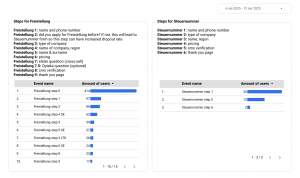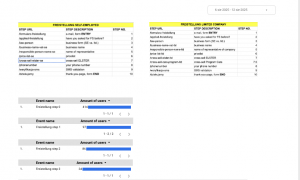At KomuKoncept, we have been collaborating for years with an international company with extensive experience in providing tax and accounting services to businesses operating in Germany. The most frequently chosen service is obtaining Freeistellung – a key document enabling the provision of services in the German market. The company has been operating since 2008, has served thousands of clients, and enjoys high recommendations.
The company operates entirely online, and one of the main points of contact with customers is the on-site form, which opens the door to collaboration. The form was extensive, operated in PWA technology, and led the user down different paths depending on the answers to initial questions, such as the nature of their business. (single person or company) and having a Steuernummer.
For our client it was crucial understanding and optimizing this process – so that more people complete the path and submit the contact form.

Challenges
Due to the form's complexity, a traditional approach to data analysis proved insufficient. The form created parallel paths and variations, which prevented the use of a simple funnel in GA4. To understand user behavior, it was necessary to detail all transition variations and then design analytics based on this.
The biggest declines in conversion occurred at unusual times – not when asking about complex tax data, but in places that were seemingly neutral.
The analytical dashboard had to take into account multiple versions of the paths, but at the same time allow for a holistic view of data and their comparison.
Our approach
User Path Mapping
First, we mapped all possible form flows (flow chart) to know:
- what questions appear in each version,
- where are the common points,
- which stages can be unified in the report.
This allowed us to plan the analytics structure so that GA4 events reflected not only subsequent screens, but also the user context (e.g. whether he/she has a Steuernummer).
Analytics configuration
The next stage was implementation Google Tag Manager (GTM) on the website and adding codes to it GA4 and HotJarThis made it possible to manage all tags centrally and quickly implement new events.
In GA4 we defined a set custom events associated with each step of the form. In practice, this meant that for every significant user interaction (e.g. go to the next question by clicking the button "Next", entering a phone number) a separate event was created, the parameters of which provided detailed context.
This allowed us to then aggregate the data in a consistent way using Looker Studio, regardless of which route the user chose.
The second element of the analysis was HotJar session recordings, which allowed us to observe real user behavior. This qualitative data complemented the numbers, showing not only where users stopped, but also how they used the form. (e.g. going back, leaving the page, long pauses).
All data has been integrated in dashboard in Looker Studio, which combined the funnels of individual paths into one holistic analysis. Based on custom events, we created a dashboard that:
- unified funnels from different paths in one comparative report,
- allowed filtering data by type of activity, presence of Steuernummer and other parameters,
- visualized drop-offs at every step – in percentages and absolute numbers,
- enabled monitoring of the effectiveness of changes over time (e.g. A/B form testing).
Behavior Analysis (Hotjar + GA4)
Quantitative data (events GA4) we compared with qualitative data (recordings Hotjar session).
This approach allowed us to identify not only where users drop out, but also Why.
The analysis revealed several areas requiring improvement. Users were abandoning the form early on when they weren't sure how long it would take. The solution was to add a brief note at the beginning of the funnel stating that it would take a few minutes to complete the form.
The most important insight
The largest drop-off occurred at phone number field, which in the original version appeared early in the form. The user was not yet sufficiently engaged and abandoned further completion. Additionally, the final SMS validation (entering code) was communicated too late.
Action implemented
- Field moved phone number closer to the end of the form (Before shipping), when the user has already invested time and effort in filling out the data.
- Added a clear message next to the phone field: "On We will send an SMS code to the number provided - enter it to confirm sending the form. — proactive justification.
- Small microcopies in earlier steps: information on how long it takes on average to fill out the form.
- Post-Change Measurement Implementation: Cohort Comparison (Before vs after) in Looker Studio.
Why it worked (analysis psychological + UX)
- The user is more engaged at the end of the process (sunk cost), so he will be more willing to provide data that requires trust (phone).
- Transparency (information o SMS) reduces concerns about spam and increases understanding of the field's purpose.


Effect
- Drop-off at the phone number entry stage dropped significantly – users who reached the end of the form were much more likely to provide their number.
- The form has become more friendly and transparent, which improved the user experience (UX).
- The Looker Studio dashboard now allows you to ongoing monitoring of funnel effectiveness and quick response to possible problems.
Conclusions
- Marketing analytics It doesn't end with simple tagging - the key is proper mapping of business processes and reflecting them in GA4 events.
- Combining quantitative data (GA4, Looker Studio) with quality (Hotjar) gives a complete picture of user behavior.
- Sometimes simple change of field order in the form can have a greater impact on conversions than complicated advertising campaigns.
✅ Thanks to analytics, the company gained better funnel, higher conversion and a tool for further optimization.
And we at KomuKoncept have once again confirmed that putting analytics it's not only "installation GA4 code”, but strategic work on data and business.
Need help with marketing?
Contact us.
Let's talk about what requires the most immediate action in your company.
We provide:
- Understanding your situation before sending an offer
- experience in B2B and B2C marketing
- close contact with top managers
- consulting approach
- knowledge of marketing and technology.

Aleksandra Dzwierzyńska
Head of Social
ola@komukoncept.pl

Michal Opydo
Managing Director
michal@komukoncept.pl

